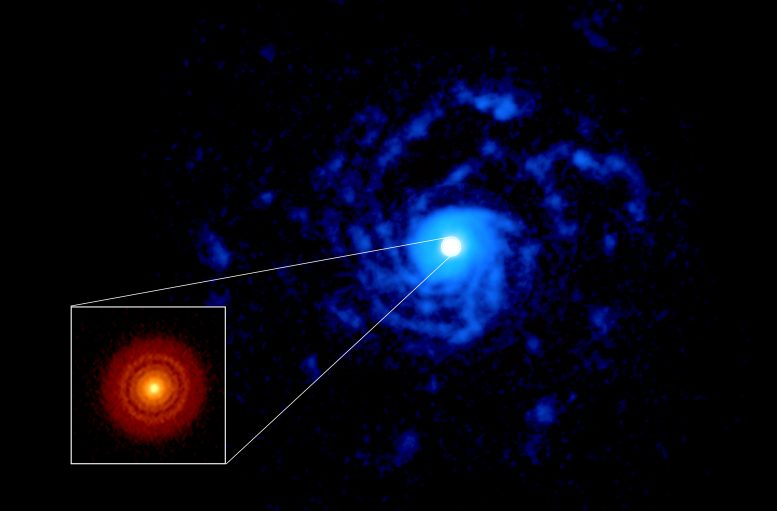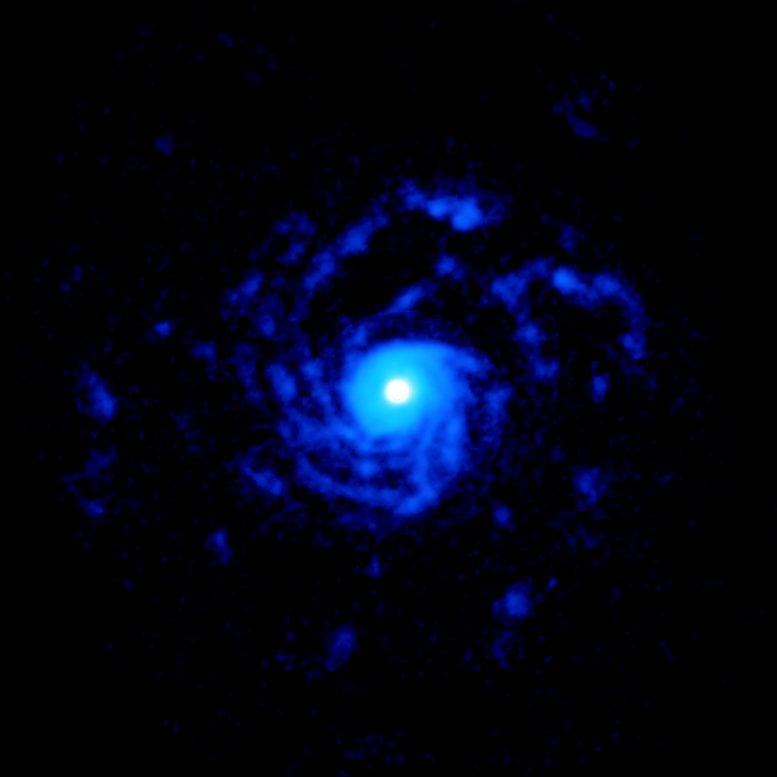
ALMA image of the planet-forming disk around the young star RU Lup. The inset image (lower left, red disk) shows a previous (DSHARP) observation of the dust disk with rings and gaps that hint at the presence of forming planets. The new observation shows a large spiral structure (in blue), made out of gas, that spans far beyond the compact dust disk. Credit: ALMA (ESO/NAOJ/NRAO), J. Huang and S. Andrews; NRAO/AUI/NSF, S. Dagnello
Planet-forming environments can be much more complex and chaotic than previously expected. This is evidenced by a new image of the star RU Lup, made with the Atacama Large Millimeter/submillimeter Array (ALMA).
All planets, including the ones in our Solar System, are born in disks of gas and dust around stars, so-called protoplanetary disks. Thanks to ALMA we have stunning high-resolution images of many of these planet factories, showing dusty disks with multiple rings and gaps that hint at the presence of emerging planets. The most famous examples of these are HL Tau and TW Hydrae.
But disks are not necessarily as neatly arranged as these initial dust observations suggest. A new ALMA image of RU Lup, a young variable star in the Lupus constellation, revealed a giant set of spiral arms made of gas, extending far beyond its more well-known dust disk. This spiral structure – resembling a ‘mini-galaxy’ – extends to nearly 1000 astronomical units (au) from the star, much farther away than the compact dust disk that extends to about 60 au.

ALMA image of the planet-forming disk around the young star RU Lup, showing a giant set of spiral arms made out of gas. The structure extends to nearly 1000 astronomical units from the star. Credit: ALMA (ESO/NAOJ/NRAO), J. Huang; NRAO/AUI/NSF, S. Dagnello
Previous observations of RU Lup with ALMA, which were part of the Disk Substructures at High Angular Resolution Project (DSHARP), already revealed signs of ongoing planet formation, hinted by the dust gaps in its protoplanetary disk. “But we also noticed some faint carbon monoxide (CO) gas structures that extended beyond the disk. That’s why we decided to observe the disk around the star again, this time focusing on the gas instead of the dust,” said Jane Huang of the Center for Astrophysics, Harvard & Smithsonian (CfA) and lead author on a paper published on August 3, 2020, in The Astrophysical Journal.
Protoplanetary disks contain much more gas than dust. While dust is needed to accumulate the cores of planets, gas creates their atmospheres.
In recent years, high-resolution observations of dust structures have revolutionized our understanding of planet formation. However, this new image of the gas indicates that the current view of planet formation is still too simplistic and that it might be much more chaotic than previously inferred from the well-known images of neatly concentric ringed disks
“The fact that we observed this spiral structure in the gas after a longer observation suggests that we have likely not seen the full diversity and complexity of planet-forming environments. We may have missed much of the gas structures in other disks,” added Huang.

RU Lup is a young, variable star. It is located in Lupus (wolf), a constellation in the Southern Sky. The star is not visible with the naked eye. Credit: IAU; Sky & Telescope magazine; NRAO/AUI/NSF, S. Dagnello
Huang and her team suggest several scenarios that could possibly explain why the spiral arms appeared around RU Lup. Maybe the disk is collapsing under its own gravity, because it is so massive. Or maybe RU Lup is interacting with another star. Another possibility is that the disk is interacting with its environment, accreting interstellar material along the spiral arms.
“None of these scenarios completely explain what we have observed,” said team-member Sean Andrews of CfA. “There might be unknown processes happening during planet formation that we have not yet accounted for in our models. We will only learn what they are if we find other disks out there that look like RU Lup.”
###
Reference: “Large-scale CO spiral arms and complex kinematics associated with the T Tauri star RU Lup” by Jane Huang, Sean M. Andrews, Karin I. Öberg, Megan Ansdell, Myriam Benisty, John M. Carpenter, Andrea Isella, Laura M. Pérez, Luca Ricci, Jonathan P. Williams, David J. Wilner and Zhaohuan Zhu, 3 August 2020, The Astrophysical Journal.
DOI: 10.3847/1538-4357/aba1e1
The team is composed of Jane Huang, Sean M. Andrews, Karin I. Öberg and David J. Wilner (Center for Astrophysics | Harvard & Smithsonian), Megan Ansdell (NASA HQ), Myriam Benisty (Universidad de Chile/IPAG France), John M. Carpenter (Joint ALMA Observatory Chile), Andrea Isella (Rice University), Laura M. Pérez (Universidad de Chile), Luca Ricci (California State University Northridge), Jonathan P. Williams (University of Hawaii), and Zhaohuan Zhu (University of Nevada).
The National Radio Astronomy Observatory is a facility of the National Science Foundation, operated under cooperative agreement by Associated Universities, Inc.
ALMA is a single telescope of revolutionary design, composed initially of 66 high-precision antennas, and operating at wavelengths of 0.32 to 3.6 mm. Its main 12-meter array has fifty antennas, each measuring 12 meters in diameter, which together act as a single telescope — an interferometer. An additional compact array of four 12-meter and twelve 7-meter antennas complements this. The 66 ALMA antennas can be arranged in different configurations, where the maximum distance between antennas can vary from 150 meters to 16 kilometers, which gives ALMA a powerful variable “zoom.” It is able to probe the Universe at millimeter and submillimeter wavelengths with unprecedented sensitivity and resolution, with a vision up to ten times sharper than the Hubble Space Telescope, and complementing images made using the VLT Interferometer.
https://scitechdaily.com/stirred-up-planet-factory-captured-by-the-revolutionary-alma-telescope/
2020-08-05 11:55:41Z
CBMiYGh0dHBzOi8vc2NpdGVjaGRhaWx5LmNvbS9zdGlycmVkLXVwLXBsYW5ldC1mYWN0b3J5LWNhcHR1cmVkLWJ5LXRoZS1yZXZvbHV0aW9uYXJ5LWFsbWEtdGVsZXNjb3BlL9IBZGh0dHBzOi8vc2NpdGVjaGRhaWx5LmNvbS9zdGlycmVkLXVwLXBsYW5ldC1mYWN0b3J5LWNhcHR1cmVkLWJ5LXRoZS1yZXZvbHV0aW9uYXJ5LWFsbWEtdGVsZXNjb3BlL2FtcC8
Bagikan Berita Ini














0 Response to "Stirred-Up Planet Factory Captured by the Revolutionary ALMA Telescope - SciTechDaily"
Post a Comment